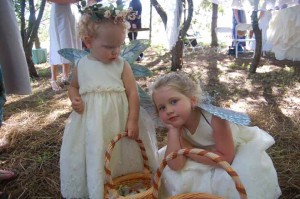Rachael and Adam’s Uber-Rad Wedding!
Not for my youngest sister Rachael the typical, Midwestern wedding at a church, followed by a fried chicken and mashed potatoes supper, a lot of beer drinking, and dancing to a too-loud band at a local rented hall. No, Rachael had an outdoor shebang in 92 degree weather with 12 bridesmaids and groomsmen, three flower fairies, a miniature bride and groom, and three bands all sweltering in their formal clothes!
Admittedly, there were a few times over the weekend when, in the midst of a thunderstorm that knocked the power out in and around Bloomington, Indiana, it occurred to me that there’s something to be said for an indoor weddings with four or five bridesmaids and one band. However, Rachael is allergic to convention, so uber-rad (her word) it was – with a wedding party composed of all five sisters and four brothers, 20-plus nieces and nephews, three great-nieces, and a mixed assortment of childhood, college and recent friends, against a backdrop of hay bales, a huge boar rolling in water, water antelopes, and a spectacular, hot-pink sunset later in the evening.
But putting those external, unorthodox elements aside, it was the ceremony itself that struck me as being most reflective of my completely unique baby sister. She and her soon-to-be husband Adam stood on a raised platform/stage and the officiant, a woman named Faith, presided over the ceremony. Neither Rachael nor Adam is affiliated with a church or a religious faith as such, so instead of readings from the Bible, they chose selections from the Muslim mystic poet, Rumi, and from Anne Morrow Lindbergh’s Gift From the Sea. The wedding party was invited to participate in a unity sand ceremony, in which we poured a small shot glass of colored sand into a large bowl, representative of the community’s involvement in the newlyweds’ lives together. Rachael’s friend, Caren, introduced the final symbolic gesture – the breaking of glasses, a la Jewish weddings. Caren explained that this act, often used to symbolize the destruction of the Jewish Temple, is a reminder that even on a day of great joy we should remember that there is suffering and pain elsewhere. Both Rachael and Adam stomped on a glass wrapped in a napkin, and Faith called out mazal tov!
I’ve never been to a non-Jewish wedding in which a glass was stomped on in recognition of others’ sufferings. My sister’s inclusion of this ritual moved me, and I admit, surprised me. It wouldn’t occur to me to co-opt a tradition from a faith not my own in any of my own life-cycle events, not because there’s anything wrong with it (on the contrary!) but because it simply wouldn’t cross my mind. Yet, when I thought about it, lots of wedding traditions were originally lifted from long-gone cultures and religions, but today are considered integral parts of most western weddings. Bouquets were originally garlands worn in the bride’s hair, made of thyme and garlic to frighten off evil spirits. The German Goths needed a best man, because he helped steal the bride from a neighboring tribe. He would then stay at the groom’s side to prevent her from being returned. Throwing rice is an old Assyrian, Hebrew and Egyptian custom symbolizing fertility. The white wedding dress dates back to England and Queen Victoria’s notions of sexual purity. The wedding cake is a Roman tradition, again symbolizing fertility (Remember that Ceres, their fertility goddess, was the goddess of wheat). All of these are components in most of today’s wedding ceremonies, but we never think, “Oh, we are one with the Goths and the Romans!”
I actually don’t know that Rachael consciously and pre-meditatedly thought to herself, “Hmm, let me be inclusive of other faiths.” It’s more that that is just who she is. For her, there is room for tradition and originality, for a serious commitment and having fun, and for a Muslim poet and a Jewish symbol to co-exist. Rachael didn’t have to make room for any of them. She knew that the room already existed. In Rachael’s wedding, there was a sense both of individuality and of community amongst this truly diverse group of people gathered for her wedding. There were devout Catholics and Christians, some Jews, atheists and agnostics; there were homophobic folks mingling with Rachael’s gay, lesbian and transgender friends. And we were all gathered together – happily! - to support Rachael and to participate in this ancient rite of passage, a public ceremony in which two people make promises to remain together for the rest of their lives. That, I thought, is one of the most important functions of ceremonies and rituals – to serve as a “container” of sorts, to offer an opportunity for individuals to come together, to leave their alienated worlds for a few moments and enter into the world of one another.
It didn’t rain at all during the ceremony. One of Rachael’s rain goddess friends was in charge of making sure of that. Quite a few of us were praying, too. There is room for everyone’s prayers.
![[the current issue of ZEEK]](../../image/2/100/0/5/uploads/leftistethicistgraphic-52842c6a.png)
- 5000 Pages of Zeek
- Founded in 2001, Zeek was the first Jewish online magazine, and we have over 5000 pages online to prove it, all available free of charge. Read more in the Archive.
More articles by
Angela Himsel
More articles in
Life and Action
- Purim’s Power: Despite the Consequences –The Jewish Push for LGBT Rights, Part 3
- Love Sustains: How My Everyday Practices Make My Everyday Activism Possible
- Ten Things You Should Know About ZEEK & Why We Need You Now
- A ZEEK Hanukkah Roundup: Act, Fry, Give, Sing, Laugh, Reflect, Plan Your Power, Read
- Call for Submissions! Write about Resistance!


